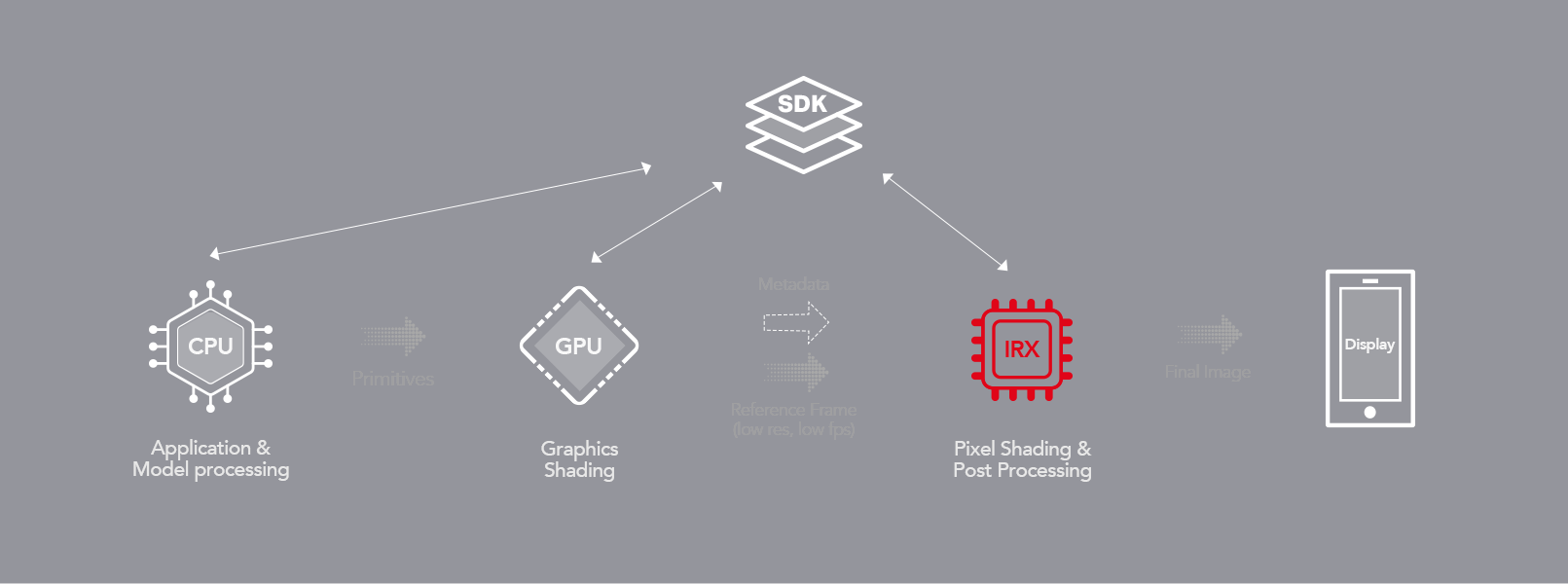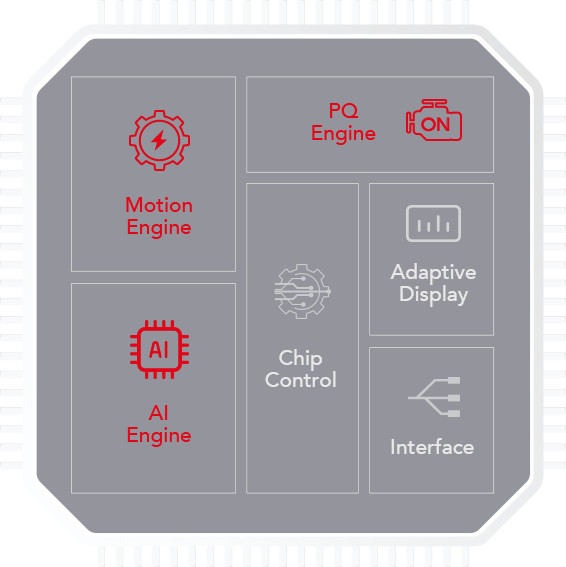
IRX Technologies
Mobile GamingLike Never Before
Distributed Rendering Architecture

The objective of distributed rendering architecture is to offload CPU/GPU tasks from computing intensive and bandwidth hungry pixel shading tasks by bringing a dedicated pixel processing into graphic rendering pipeline. By coordinating with CPU/GPU, the IRX hardware accelerator can deliver up to 20+ times increase in rendering capability for mobile devices. For mobile game developers, there are three computing units to choose from, namely, CPU excels in model calculation, GPU excels in vertex rendering, and IRX rendering accelerator excels in pixel-level rendering. Depending on the specific characteristics and requirements of the game, developers can flexibly allocate computing resources to obtain the optimal gaming experience.

Under the distributed rendering architecture the Application Processor (CPU/GPU) focuses on rendering tasks delivering more accurate models, higher level of details, more realistic illimitation etc. and presents relatively low resolution and low frame rate images to the Rendering Accelerator. The Rendering Accelerator reconstruct the image spatially with up to 4 times of resolution and temporally with up to 6 times of frame rate. In addition, the Rendering Accelerator can further apply post processing functions to the final images before presenting to display.


Acceleration Engines
The rendering acceleration engine consists of three sub-engines: Motion Engine, AI Engine, and Picture Quality Engine.
The Motion Engine focuses on enhancing the content rendering in terms of frame rate on mobile devices. Unlike the traditional GPU-based model and vertex rendering approach, the IRX motion engine adopts an image-based rendering method, significantly increasing the system's output frame rate at a remarkably low power consumption cost.
The AI Engine is based on neural networks optimized for specific application domains, supplemented by inference models optimized for content, to achieve ultra-low-power pixel processing. It can be used to enhance image resolution, optimize image details, and improve image quality, etc. Game developers can utilize the capabilities of the AI Engine to reduce the resolution of GPU pixel rendering, thereby presenting high-resolution, high-definition images on the screen.
The Picture Quality Engine focuses on addressing pain points for game developers in the post-processing stage (such as high computational loads and excessive memory bandwidth usage). Through collaboration with other rendering acceleration engines, the Image Quality Engine can achieve functions such as color management, HDR tone mapping, and anti-aliasing.
The Motion Engine focuses on enhancing the content rendering in terms of frame rate on mobile devices. Unlike the traditional GPU-based model and vertex rendering approach, the IRX motion engine adopts an image-based rendering method, significantly increasing the system's output frame rate at a remarkably low power consumption cost.
The AI Engine is based on neural networks optimized for specific application domains, supplemented by inference models optimized for content, to achieve ultra-low-power pixel processing. It can be used to enhance image resolution, optimize image details, and improve image quality, etc. Game developers can utilize the capabilities of the AI Engine to reduce the resolution of GPU pixel rendering, thereby presenting high-resolution, high-definition images on the screen.
The Picture Quality Engine focuses on addressing pain points for game developers in the post-processing stage (such as high computational loads and excessive memory bandwidth usage). Through collaboration with other rendering acceleration engines, the Image Quality Engine can achieve functions such as color management, HDR tone mapping, and anti-aliasing.
The rendering acceleration engine consists of three sub-engines: Motion Engine, AI Engine, and Picture Quality Engine.
The Motion Engine focuses on enhancing the content rendering in terms of frame rate on mobile devices. Unlike the traditional GPU-based model and vertex rendering approach, the IRX motion engine adopts an image-based rendering method, significantly increasing the system's output frame rate at a remarkably low power consumption cost.
The AI Engine is based on neural networks optimized for specific application domains, supplemented by inference models optimized for content, to achieve ultra-low-power pixel processing. It can be used to enhance image resolution, optimize image details, and improve image quality, etc. Game developers can utilize the capabilities of the AI Engine to reduce the resolution of GPU pixel rendering, thereby presenting high-resolution, high-definition images on the screen.
The Picture Quality Engine focuses on addressing pain points for game developers in the post-processing stage (such as high computational loads and excessive memory bandwidth usage). Through collaboration with other rendering acceleration engines, the Image Quality Engine can achieve functions such as color management, HDR tone mapping, and anti-aliasing.
The Motion Engine focuses on enhancing the content rendering in terms of frame rate on mobile devices. Unlike the traditional GPU-based model and vertex rendering approach, the IRX motion engine adopts an image-based rendering method, significantly increasing the system's output frame rate at a remarkably low power consumption cost.
The AI Engine is based on neural networks optimized for specific application domains, supplemented by inference models optimized for content, to achieve ultra-low-power pixel processing. It can be used to enhance image resolution, optimize image details, and improve image quality, etc. Game developers can utilize the capabilities of the AI Engine to reduce the resolution of GPU pixel rendering, thereby presenting high-resolution, high-definition images on the screen.
The Picture Quality Engine focuses on addressing pain points for game developers in the post-processing stage (such as high computational loads and excessive memory bandwidth usage). Through collaboration with other rendering acceleration engines, the Image Quality Engine can achieve functions such as color management, HDR tone mapping, and anti-aliasing.

